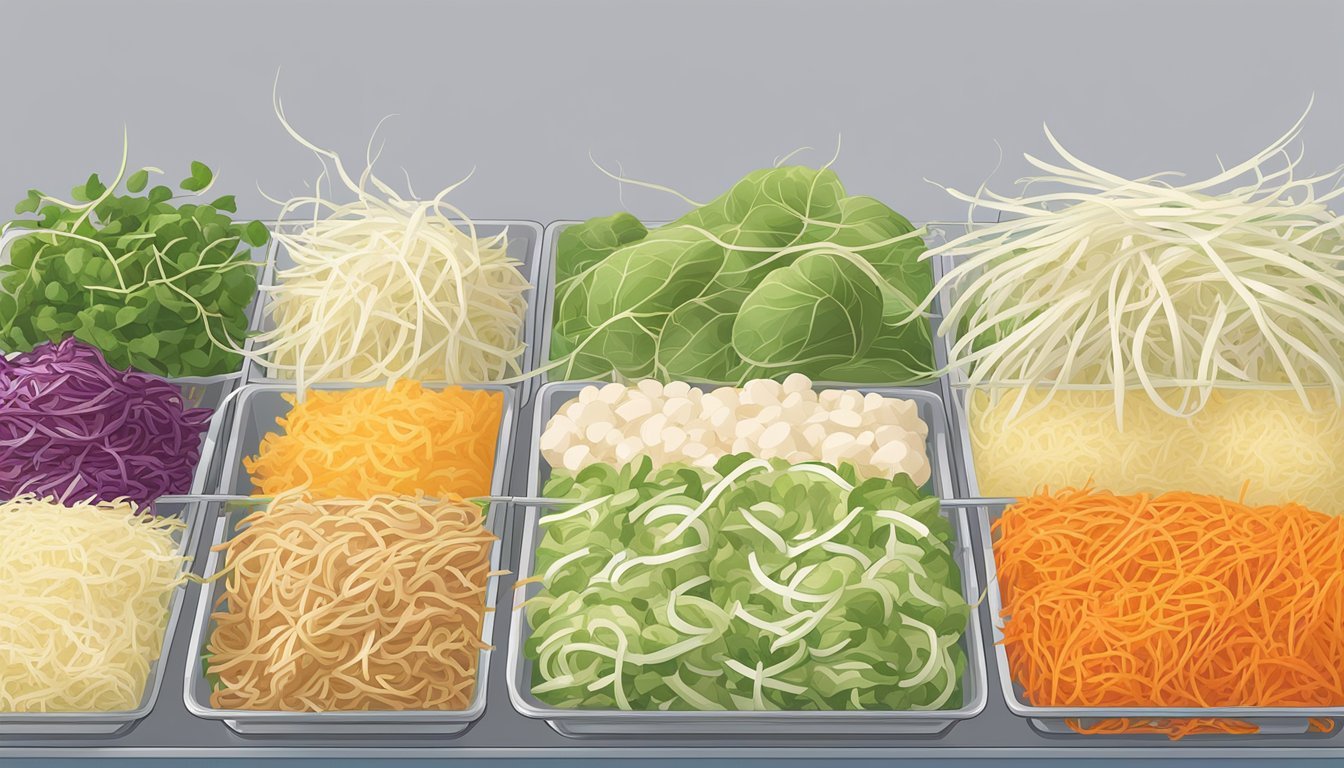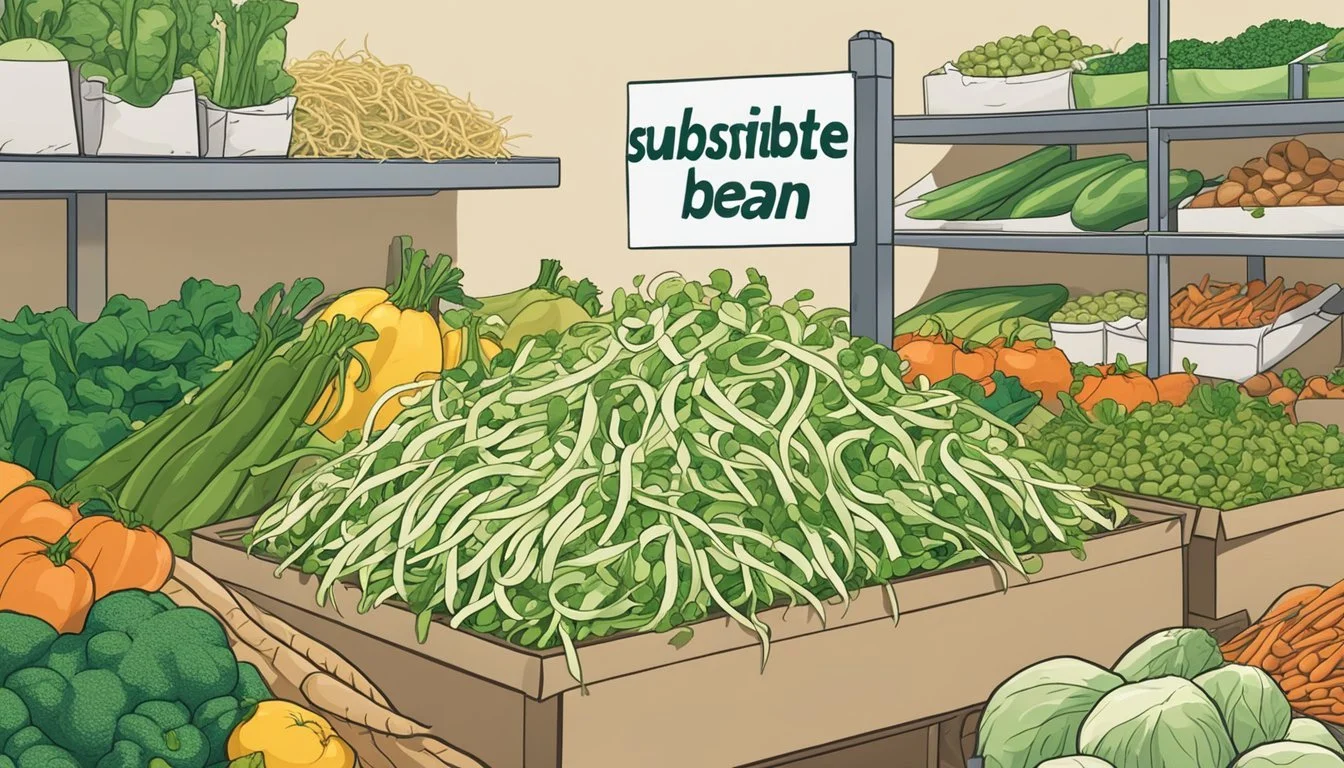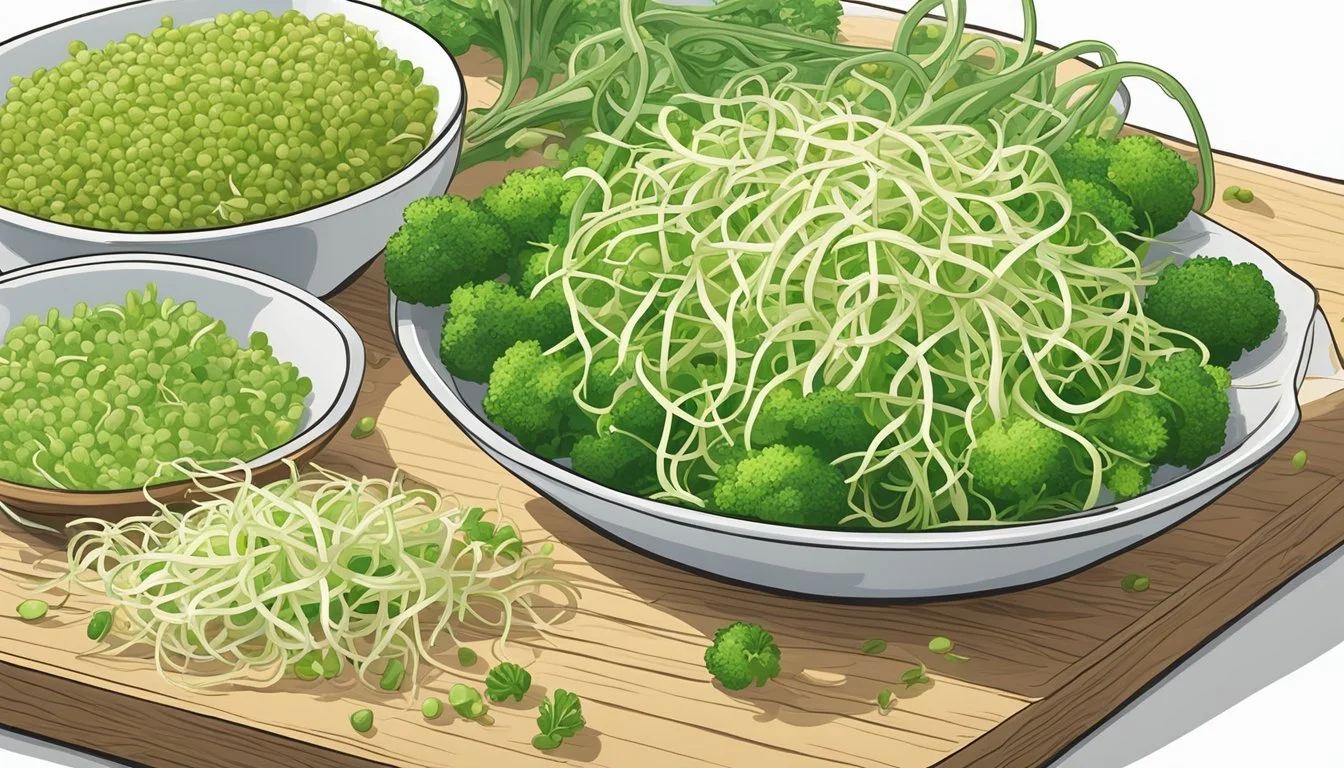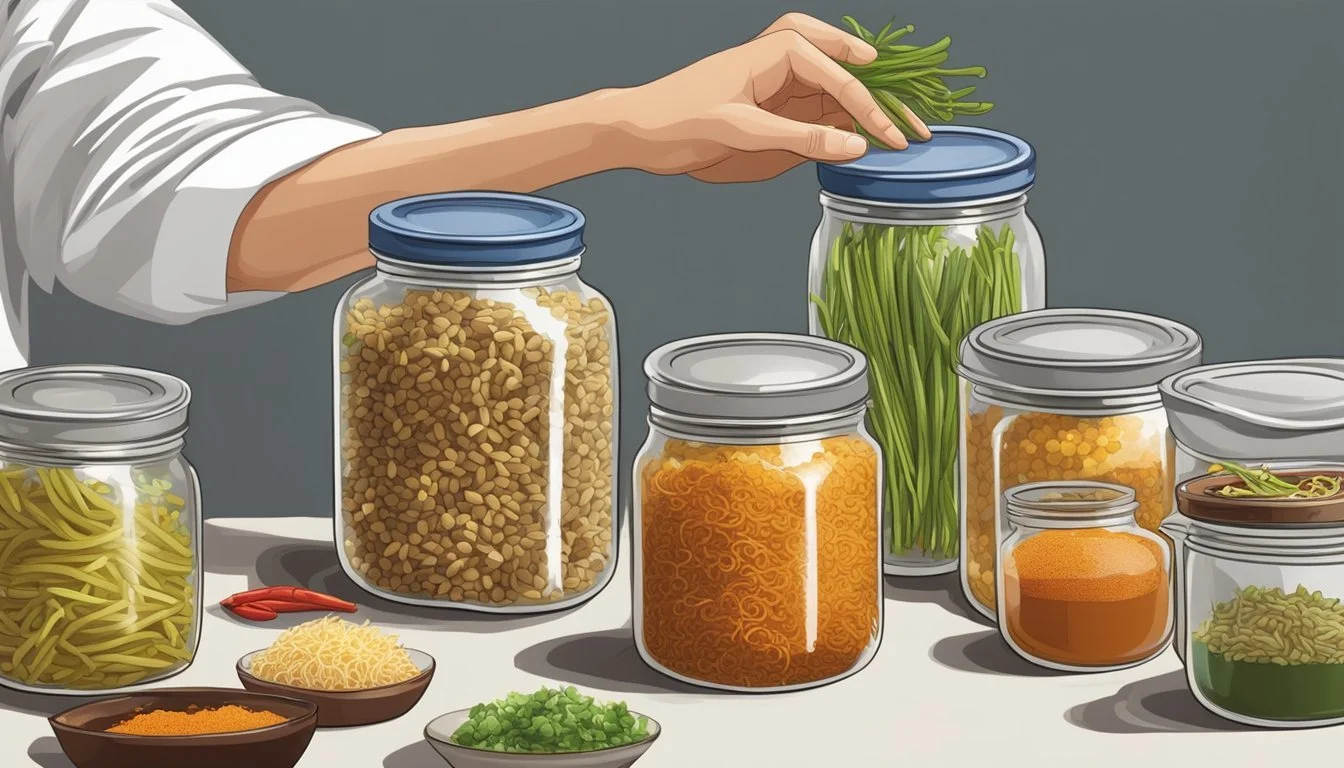Bean Sprouts Substitutes
Top Alternatives for Your Recipes
Bean sprouts are a popular addition to many dishes due to their crunchy texture and mild flavor, but what happens when you don’t have them on hand? Luckily, there are several other vegetables that can step in and provide similar benefits. Radishes, for instance, bring a spicy kick and vitality to recipes, making them a great alternative for bean sprouts in dishes with bold flavors.
When seeking a mild and sweet substitute, shredded carrots are a delicious option that can add both color and texture to your meals. Snow peas or snap peas can also mimic the crunch you’d get from bean sprouts and introduce a fresh, slightly sweet taste. These substitutes not only enhance your dishes but also keep them nutritious and low in calories.
For those who enjoy more exotic ingredients, bamboo shoots offer a unique, firm texture that closely resembles bean sprouts. They are versatile and can be used in a range of dishes from spring rolls to soups. Choosing the right substitute ensures that your meals remain healthy, vibrant, and satisfying, even without the classic bean sprouts.
Understanding Bean Sprouts
Bean sprouts, including mung bean and soybean sprouts, are nutrient-dense and versatile ingredients used in a variety of dishes such as stir-fries, salads, and soups. They are a rich source of vitamins and minerals, adding both flavor and health benefits to meals.
What Are Bean Sprouts?
Bean sprouts are young shoots that come from germinated beans, primarily mung beans and soybeans. They are a staple in many Asian cuisines, valued for their crunchy texture and subtle, slightly nutty flavor. Mung bean sprouts are typically shorter and more delicate, while soybean sprouts tend to be larger and have a more pronounced taste.
Nutritional Profile
Bean sprouts pack a nutritional punch. They are high in vitamin C, which aids in immune function, and vitamin K, crucial for blood clotting and bone health. Iron found in bean sprouts supports oxygen transport in the body, while protein and fiber contribute to muscle growth and digestive health respectively. Compared to fully grown beans, sprouts offer a lower calorie option yet retain substantial nutrient content.
Common Uses in Cuisine
Bean sprouts are highly versatile in cooking. In Asian dishes, they are commonly added to stir-fries and soups to provide a crunchy texture and fresh taste. They are also a popular ingredient in salads, offering a crisp bite. In spring rolls, bean sprouts add a refreshing contrast to other ingredients. For a unique twist, they can be used in sandwiches to enhance crunch and nutritional value.
By integrating mung bean sprouts or soybean sprouts into various recipes, one can enjoy both the health benefits and the textural enhancement they bring to dishes.
Why Substitute Bean Sprouts?
Substituting bean sprouts may be necessary due to preferences in texture and flavor, dietary restrictions, or availability in your local market.
Variations in Texture and Flavor
Bean sprouts are appreciated for their crunchy texture and mild flavor. However, some recipes might benefit from alternatives. For instance, snow peas or snap peas offer a similar crunch but with a slightly sweet taste. Radishes, on the other hand, provide a spicy kick, making them ideal for dishes with strong flavors.
Shredded carrots are a good substitute, adding both sweetness and color to the dish. Bamboo shoots mimic the texture quite well and can take on the flavors of the surrounding ingredients effectively. These substitutes can help tailor the mouthfeel and taste profile precisely to the dish's requirements.
Dietary Restrictions and Allergies
Individuals may need to replace bean sprouts due to dietary restrictions or allergies. Some people might be allergic to certain types of legumes, which include bean sprouts. Others might be on special diets that restrict the consumption of certain vegetables.
Leafy greens such as bok choy or spinach can be a nutritious alternative, being rich in vitamins and minerals. Alfalfa sprouts and sunflower sprouts are suitable substitutes that provide a different nutritional profile while avoiding common allergens. Careful consideration of these factors ensures that all diners can enjoy the meal safely.
Availability Issues
In some regions, bean sprouts may not always be readily available due to seasonal or supply chain constraints. This scarcity can be problematic, especially if they are a crucial component of your dish.
Cabbage, when shredded, provides a good volume and similar texture. Rice noodles and soba noodles can also be viable options in noodle dishes that require the crunch and freshness of bean sprouts. Mung beans, which are often the source of bean sprouts, can also be cooked in different ways to provide similar benefits in dishes. These substitutes offer solutions for maintaining the desired texture and mouthfeel even when the primary ingredient is not accessible.
Top Bean Sprout Substitutes
When bean sprouts are unavailable, various vegetables and sprouts can serve as excellent alternatives. Each substitute offers unique textures and flavors that can complement a variety of dishes.
Alfalfa Sprouts
Alfalfa sprouts are popular for their mild flavor and crunchy texture. They are smaller and more delicate than bean sprouts, making them perfect for sandwiches, salads, and wraps. Alfalfa sprouts are also nutritious, providing a good source of vitamins C and K, as well as fiber.
Usage Tips:
Add alfalfa sprouts to fresh salads for a crunchy element.
Use in sandwiches and wraps to enhance texture.
Incorporate into smoothies for an extra nutritional boost.
Snow Peas and Snap Peas
Snow peas and snap peas are excellent substitutes for bean sprouts due to their similar crunchiness. Snow peas have a slightly sweet taste and are often used in stir-fries, while snap peas are thicker and juicier.
Usage Tips:
Slice snow peas or snap peas thinly for salads and stir-fries.
Add to soups and spring rolls for added texture.
Ideal for use in Asian dishes such as pad thai.
Cabbage Varieties
Cabbage, particularly napa or green cabbage, can be shredded to mimic the texture of bean sprouts. It adds a slight sweetness and crunch. Cabbage is versatile and can be used in raw dishes or cooked recipes.
Usage Tips:
Shred cabbage for use in salads and slaws.
Add to soups and stir-fries for texture and flavor.
Use in spring rolls or as a wrap substitute.
Green Vegetables
Leafy green vegetables such as spinach, kale, and bok choy can replace bean sprouts. These greens provide more flavor and nutrients while offering a different texture.
Usage Tips:
Add raw leafy greens to salads for a nutrient boost.
Sauté greens as a side dish or mix into stir-fries.
Use in soups for added depth of flavor.
Soybean and Other Legume Sprouts
Soybean sprouts are a direct alternative to mung bean sprouts with a similar texture but slightly nutty flavor. Other legume sprouts like pea sprouts can also work, adding variety and nutrition.
Usage Tips:
Use soybean sprouts in stir-fries and soups.
Add pea sprouts to salads for a fresh, crunchy texture.
Incorporate legume sprouts in wraps and sandwiches for added crunch.
By considering these substitutes, dishes that require bean sprouts can maintain their desired taste and texture even in the absence of the specific ingredient.
Substitutes for Specific Dishes
When replacing bean sprouts, it's important to consider the specific dish and its flavor, texture, and nutritional requirements. Different substitutes may work better for Asian cuisine, Western dishes, and those focused on health benefits.
Asian Cuisine Alternatives
In Asian cuisine, alternatives to bean sprouts maintain texture and complement traditional flavors. Snow peas and snap peas are excellent choices for stir-fries and pad thai, offering a similar crunch and crisp freshness.
Bamboo shoots are another good substitute, particularly in noodle dishes and stews, due to their unique texture and ability to absorb flavors. For sushi, shredded cabbage works well, adding volume and a slight crunch without overpowering other ingredients.
Western Dishes and Salads
For Western dishes and salads, texture and freshness are key. Shredded carrots can be used as they add a bit of sweetness to salads and sandwiches. Radishes providing a spicy kick, are great in salads and wraps where a bit of punch is desired.
Mushrooms, especially enoki mushrooms, offer a versatile option. Their mild flavor and delicate texture suit everything from soups to garnishes in various Western-style dishes.
Healthy and Nutrient-Dense Options
For those focused on health and nutrient density, options like alfalfa sprouts, sunflower sprouts, and pea sprouts are excellent substitutes. These options are rich in vitamins and antioxidants, making them ideal for boosting the nutritional content of meals.
Soybean sprouts offer a protein-rich alternative for those seeking a more filling substitute. Lentil and chickpea sprouts can be added to a variety of dishes, supporting a health-conscious diet while maintaining the desired sprout-like texture.
Considerations When Choosing Substitutes
When selecting a substitute for bean sprouts, it is crucial to consider the impact on both flavor and texture in your dish. The chosen alternative should complement the overall profile of the dish and provide a similar crunch and nutritional benefit where possible.
Taste and Palate Compatibility
Taste compatibility is a primary concern when choosing a bean sprout substitute. Bean sprouts have a mild, slightly nutty flavor, and some best substitutes will match this profile.
Snow peas and snap peas offer a fresh, slightly sweet taste that can blend well in similar dishes. Bok choy has a milder flavor but adds depth, making it a versatile substitute. When a spicier flavor is desired, radishes provide a bolder taste.
Ensure to choose a substitute that adapts well to the dish's flavor without overpowering it. Substitutes with neutral flavors like shredded cabbage can replace bean sprouts without altering the dish's intended flavor profile much. Nutritional aspects like vitamin K, folate, and calcium content should also be considered to maintain the dish's health benefits.
Textural Elements in Dishes
Bean sprouts are valued for their crunchy texture, which introduces a contrasting element to many dishes. Maintaining this texture is critical when selecting substitutes.
Bamboo shoots are a close match due to their firm and crisp structure, making them an excellent alternative in stir-fries and salads. Alfalfa sprouts can also be substituted for a lighter crunch, suitable for sandwiches and wraps. When replacing bean sprouts in soups, snow peas or cabbage can provide similar crunchiness and resilience.
Additionally, shredded carrots can add a sweet crunch, enhancing both flavor and texture. Consider the dish's original textural dimensions to select a substitute that preserves or improves the eating experience.
How to Prepare and Cook with Substitutes
When using substitutes for bean sprouts, attention to the preparation and cooking methods is crucial to achieve the desired texture and flavor. Here are specific guidelines on how to handle and cook these alternatives effectively.
Cleaning and Preparing Vegetables
Proper cleaning of vegetables like snow peas, leafy greens, and mushrooms is the first step. Snow peas should have their strings removed before rinsing under cold water.
Leafy greens, such as spinach or kale, need to be thoroughly washed to remove any dirt or sand. Shredded carrots should be peeled and rinsed. Bamboo shoots require peeling if fresh, and canned ones should be rinsed to remove any preservatives.
Mushrooms like button or shiitake should be wiped with a damp cloth to clean.
Adjustments in Cooking Methods
Since substitutes like snow peas and mushrooms can vary in texture from bean sprouts, cooking times and methods should be adjusted accordingly.
Snow peas should be quickly stir-fried to maintain their crispness. Leafy greens might need just a brief sauté to soften. Shredded carrots can be added directly to stir-fries, but for soups, a slight pre-cook can help maintain texture.
Bamboo shoots can mimic the crunchy texture of bean sprouts if cooked briefly. Different cooking times might apply for mushrooms given their variety; a quick sauté could balance their tenderness with the desired crunch from a substitute like bean sprouts.
Maximizing Health Benefits with Bean Sprout Alternatives
When substituting bean sprouts, there are various nutrient-dense alternatives that can cater to specific dietary needs and enhance health benefits. These alternatives can help boost nutrient intake, support immune function, and improve overall well-being.
Incorporating High-Nutrient Options
Broccoli Sprouts: These are rich in antioxidants and vitamin C, which strengthens the immune system. They also contain fiber, aiding digestion and maintaining healthy blood sugar levels.
Enoki Mushrooms: Containing a range of vitamins and minerals, enoki mushrooms are excellent for boosting immune health and contributing to a balanced diet. They are particularly rich in potassium, which helps regulate blood pressure.
Shredded Carrots: High in beta-carotene, which the body converts into vitamin A, shredded carrots support eye health and the immune system. They also provide a natural sweetness that can enhance various dishes.
Bamboo Shoots: Not only do bamboo shoots offer a similar texture to bean sprouts, but they are also a good source of dietary fiber. This helps in maintaining gut health and can aid in weight management.
Contributions to Dietary Needs
Cabbage: Packed with vitamin C, calcium, and iron, cabbage is a powerhouse of essential nutrients. It supports bone health due to its calcium content and helps in oxygen transport thanks to its iron levels.
Snow Peas: Snow peas are rich in vitamins A, C, and K, along with iron and fiber. Their crunchy texture and sweet taste make them suitable for salads and stir-fries. The vitamin K found in snow peas is important for bone health and blood clotting.
Radishes: Offering a spicy and flavorful alternative, radishes are excellent for dishes with strong flavors. They are rich in antioxidants, which help to fight oxidative stress and reduce inflammation.
Sunflower Sprouts: These sprouts are a great source of essential fatty acids, proteins, and vitamins such as vitamin E. They promote heart health and provide energy, making them a robust choice for enhancing nutritional intake.
Exploring International Flavors
When looking for bean sprout substitutes, Asian and global cuisines offer a variety of options that can enhance different dishes. These alternatives retain the freshness and crunchiness of bean sprouts while adding unique flavors and textures.
Asian Dish Enhancements
Asian cuisine provides numerous substitutes for bean sprouts, each bringing its own distinct character to the dishes. Bok choy (Chinese cabbage) serves as a versatile alternative, especially in stir-fries and noodle dishes. It offers a similar crunch and can easily absorb the flavors of sauces.
Napa cabbage can also be thinly sliced and used in place of bean sprouts. It adds a subtle sweetness and crisp texture to soups and spring rolls. Radishes, with their spicy and refreshing taste, can substitute in dishes like Japanese sushi rolls, giving a vibrant color contrast and zesty flavor.
Additional possibilities include shredded carrots and snow peas. Shredded carrots add natural sweetness and a vivid orange hue, making them excellent in salads and as toppings for Asian noodle soups. Snow peas, when sliced, match the crunchiness and freshness bean sprouts are known for.
Global Ingredients as Alternatives
Beyond Asian cuisine, global ingredients also offer valuable alternatives. Water chestnuts, widely used in Chinese cuisine, mimic the crunch of bean sprouts and are perfect for stir-fries and salads. They add a mild sweetness and a juicy bite.
For a more earthy flavor, bamboo shoots can replace bean sprouts in various dishes. Though a different species, they replicate the texture and can enhance soups, spring rolls, and more.
Enoki mushrooms present another exciting substitute. Common in Japanese dishes and known for their slender structure and mild flavor, they blend well into hot pots, salads, and noodle dishes.
With such a variety of substitutions available, anyone can find the perfect ingredient to replicate the texture and flavor profile of bean sprouts, enriching their culinary creations with diverse tastes from around the world.








